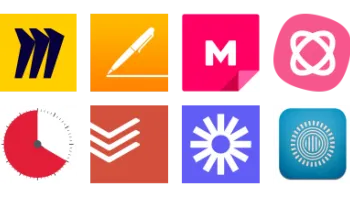Take a look inside 7 images
Evernote
Pros: Too many features to list make for a truly interactive and integrated notebook and productivity tool.
Cons: Premium plans can get pricey, and it lacks some accessibility features that would benefit students with special needs.
Bottom Line: It's a secure, easily accessible place for students and teachers to store and share their digital notes and files.
Think of Evernote as an organizable catch-all for notes, web clips, files, images, and more. Take kids through the entire writing process, from brainstorming to publishing: Start with a list of ideas, use one of the graphic organizers to get some structure, and then draft a paper. Have kids share their writing with peers for editing, make revisions, and submit the final draft. If it's a research paper, have kids take advantage of the ability to clip resources from the web or annotate shared files, making for easier work citing pages later on.
Evernote's not just for writing. Science or social studies teachers can teach kids to take Cornell notes using a customized template. Math teachers can have kids work out a problem in writing or use any of the markup features to label shapes or analyze word problems. English language learners (ELLs) or students studying a foreign language can submit a voice memo to practice speaking. And art teachers can import and share an image from a site like Google Arts and Culture and ask students to annotate features of the piece. Whether you're using the site for student work or just want to manage your own workload, this is one of those tools that molds to fit your needs.
Evernote is a cloud-based platform for storing, saving, and sharing digital notes and files created across a wide range of devices and applications. Accounts range from free, which syncs across two devices, to the somewhat pricey Premium or Business, which sync across an unlimited number of devices. Creating notes is as simple as tapping the plus sign, and the user-friendly interface is rich with features but doesn't take much time to learn. Students can create handwritten or text-based notes, annotate images, customize templates, attach files, create checklists, and more. Notes can be formatted, tagged, shared, exported to cloud drives, or simply stored until you need them. Search by tags, favorites, or keywords for quick access, even with handwritten notes and images. And integrations with other Evernote apps, Google, Microsoft, Slack, and Salesforce promote cross-platform productivity for users at all levels.
Students do need to sign up for accounts with an email and password, so teachers using Evernote in the classroom will want to ensure that they're complying with laws that govern kids' privacy. Users may experience syncing issues from time to time, but since the site keeps multiple versions of notes, it's more of a minor inconvenience than a major concern. Also, while the voice recording feature is a nice option, there's no screen reader, so students who struggle with reading or visual impairment might require additional support.
The bottom line with Evernote is that it's a one-stop storage location for anything and everything one might curate or create. Of course, kids will only get out of it what they put in, but since they can grab content from so many sources -- images, teacher or student-shared notes and files, web resources, and even email inboxes -- it's not as intimidating as a blank notebook or word processing tool where they have to figure out how to fill page after page. And since students can share content and message one another via the chat feature, the tool is an easy fit for collaborative assignments.
That said, developing good note-taking, organizational, and communication skills will take practice. It's easy to become a digital content hoarder, so students should be mindful of archiving notes into notebook stacks and deleting those they no longer want. Students who are afraid they might need something someday need not worry: You can recover even deleted files until you empty your trash can. Teachers will also want to be mindful of what kids are sharing and talk to their students about appropriate digital communication. Students will need a little practice with the site before understanding why they would want to use it, but once they grasp the experience, they'll likely find it an invaluable writing, collaboration, and storage tool.

















